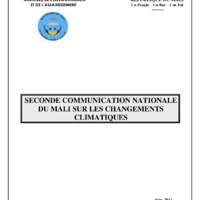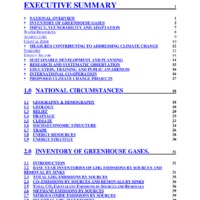Recherche
2 items
Mali seconce communication cc
A l'instar de plus de 150 pays de la Communauté Internationale, le Mali, a adopté le 9 Mai 1992 au siège de l'Organisation des Nations Unies (ONU) à New York, la Convention Cadre des Nations Unies sur les Changements Climatiques (CCNUCC). La même année, en Juin 1992, il a signé cette Convention lors de la Conférence des Nations Unies sur l'Environnement et le Développement tenue à Rio de Janeiro. La ratification de la Convention a été faite le 28 Décembre 1994. L'objectif ultime de la Convention sur les Changements Climatiques, en référence à son article 2, est de "stabiliser conformément aux dispositions pertinentes de la Convention, les concentrations de Gaz à Effet de Serre (GES) dans l'atmosphère à un niveau qui empêche toute perturbation anthropique dangereuse du système climatique. Il conviendra d'atteindre ce niveau dans un délai suffisant pour que les écosystèmes puissent s'adapter naturellement aux changements climatiques, que la production alimentaire ne soit pas menacée et que le développement économique puisse se poursuivre d'une manière durable". Pour atteindre cet objectif ultime, les Parties Contractantes à la Convention prendront des mesures en veillant sur un certain nombre de principes (article 3). Selon l'article 12 de la Convention, chaque pays parti doit fournir régulièrement à la communauté internationale des informations sous forme de communication nationale Parmi ces informations figurent "un inventaire national des émissions anthropiques par ses sources et de l'absorption par ses puits, de tous les gaz à effet de serre non réglementés par le protocole de Montréal". Le pays doit également fournir "une description générale des mesures qu'il prend ou envisage de prendre pour appliquer la Convention" ainsi, que toute autres informations que la partie juge utile pour atteindre l'objectif de la Convention. Conformément à cet article, le Mali a réalisé pour sa Seconde Communication Nationale les études suivantes : • La présentation du contexte national ; • Les inventaires des émissions de GES pour l'année 2000 (qui a été choisie comme année de référence au niveau international) pour l’élaboration des secondes Communications Nationales ( SCN) ; • L’élaboration d’un programme d’atténuation des émissions de gaz à effet de serre dans les secteurs prioritaires comme l’énergie, la foresterie, l’agriculture ; • l'Etude sur la Vulnérabilité/Adaptation aux effets des changements climatiques dans certains secteurs prioritaires comme l'Agriculture et les ressources en Eau ; 7 • L’élaboration d’un programme d’adaptation aux effets néfastes des changements climatiques. D’autres efforts pertinents (fournis par le pays) et allant dans le sens de la mise en œuvre de la Convention ainsi que les contraintes et les besoins liés à cette mise en œuvre ont également été mentionnés. Avec le concours de ses partenaires au développement et des organismes internationaux, le Mali est en train de mettre en œuvre un programme global d'actions stratégiques pour la préservation des ressources de l'Environnement. Ce programme prendra en compte toutes les stratégies développées dans les études techniques. Nous adressons nos vifs remerciements à nos partenaires en particulier le FEM et le PNUD, dont le soutien financier a permis l'élaboration de la présente Communication Nationale. Qu’il me soit aussi permis de remercier tous les experts nationaux qui ont apporté leur contribution lors des différentes études.
PANA Ghana
Ghana lies on the south central coast of West Africa between latitudes 4.50N and 11.50N and longitude 3.5oW and 1.3oE. It shares a common border with the Republic of Togo on the east, Burkina Faso on the north and la Cote d’Ivoire on the west respectively. Ghana covers an average area of 238,539 square kilometers. Extensive water bodies including the Lakes Volta and Bosomtwe occupy 3,275 square kilometers while seasonally flooded lakes occupy another 23,350 square kilometers. The territorial waters extend 200 nautical miles out to sea. The country's population is estimated at 19.7 million (1999) and is believed to be growing at a rate between 2.8 and 3.0 percent per annum. The birth rate is estimated at 39 per thousand (1999) while the death rate is estimated at 10 per thousand (1999). The rate of infant mortality is approximately 66 per thousand life births while the overall life expectancy is 59 years (1999). The total fertility rate within the period 1996 to 1999 is estimated as 6.0. All the major rivers in Ghana flow into the sea (see figure 2.4). The only area of internal drainage is found around Lake Bosomtwe, where only streams flow from the surrounding highlands into the lake. The river valleys show diverse characteristics. The valleys of all the major rivers are bordered by terraces showing the former width and height of the rivers. Whilst some of the valleys are guided in their direction by relief (Morago river for example flows east-west along the foot of the Gambaga escarpment) or by structure. The two main sources of water supply for the rivers are rainfall and spring. In areas with single rainfall maximum as in the north, the rivers are intermittent. However, in areas with high and well distributed rainfall within the year, the rivers flow throughout the year. Temperatures throughout the country are typically high. The mean annual temperature is generally above 24ºC, a consequence of the low latitude position of Ghana and the absence of high altitude areas. Average figures range between 24 and 300C although temperatures ranging from 18 to 40ºC or more are common in the southern and northern parts respectively. Spatial variability of temperature is experienced in terms of the diurnal and annual ranges as a result of distance from the modifying influence of the sea breeze. Generally rainfall in Ghana decreases from south to north. The wettest area is the extreme southwest where annual rainfall is about 2000mm. In the extreme north, the annual rainfall is less than 1100mm. The driest area is the wedgelike strip from east of Sekondi-Takoradi, extending eastward up to 40km where the annual rainfall is about 750mm. The dry conditions in the southeastern coastal strip are anomalous and are the cause of important differences in ecology and landuse from the rest of the country. Ghana is classified as a developing country with a per capita income GDP of US$ 390 (1996). Agriculture and livestock constitute the mainstay of Ghana’s economy, accounting for 25.4& of GDP in 1996. Although cocoa is perhaps the country’s best known crop, other food crops and livestock are by far the most important contributors to agricultural output and alone make up around 25& of GDP (1996). 2 Agriculture and livestock employs 55& of the economically active population. It is predominantly small holder, traditional and rain-fed, with 85& of the country’s 1.8 million farms being smaller than 2 hectares. Only about 12& of Ghana's land area (28, 680km2) is classified as arable or permanently cropped land. Cocoa is the main cash crop and is grown on 40& of the cropped land. It accounts for about 75& of agricultural exports. Other commercially important tree crops are oil palm, coconut palm, rubber, kola and robusta coffee. The strong dependence on agriculture for economic development is of great concern with respect to potential climatic changes. Since almost all the national agricultural production is based on rainfall, the country’s agricultural output is directly influenced by weather patterns. During periods of severe drought crop production and livestock herds decline quite significantly. The severe food shortage experienced in the country in the early 1980's is a clear testimony of the dependence of the country's agriculture on climate change

